Table of Contents
Definition
noun
plural: roughages
rough·age, ɹʌf’ɪdʒ
(1) A dietary fiber
(2) Hay or any other coarse feed, such as fodder
Details
Overview
Roughage pertains to the dietary fiber, which is a portion in a food that is of plant origin and that is indigestible to certain animals, including humans. There are animals, though, such as ruminants, that can digest them. In this case, roughage also pertains to the hay or any coarse feed that is part of the ruminant diet.
Dietary fiber
A dietary fiber pertains to the coarse, indigestible plant matter. Most of them occur as complex carbohydrates. Carbohydrates belong to a major group of biomolecules that primarily function as an energy source. They can be grouped into complex and simple. Simple carbohydrates include the simple sugars made up of one or two saccharide units whereas complex carbohydrates are those that are made up of more than two saccharides. In humans, simple carbohydrates are easily digested and readily metabolized; complex carbohydrates take longer time to be broken down into simpler forms, and when eaten, stimulate intestinal peristalsis. Complex carbohydrates are often high in fiber. Not all dietary fibers are carbohydrates, though. For instance, lignin is considered as a dietary fiber1. It is not a carbohydrate but it belongs to a group of aromatic alcohols. Plants produce lignin as a binder for the cellulose fibers. Its presence adds strength and stiffness to their cell walls.
Dietary fiber vs Starch
Dietary fiber is different from plant starch. Both of them are complex carbohydrates occurring naturally in plants. They are formed by two or more repeating units linked together by glycosidic bonds. However, dietary fibers are non-starch and have a structural role. Starch, in contrast, is produced and used by plants as a storage polysaccharide. Plants store carbohydrates in the form of starch while they produce fibers as structural component like in cell walls.
Soluble fiber vs Insoluble fiber
Dietary fiber has two major components: (1) soluble fiber and (2) insoluble fiber. By soluble, it means the fiber is water-soluble. In plants, soluble fibers occur chiefly in their fruits. When humans ingest them, they travel through the gut and often reach the colon intact. Humans do not have the necessary enzymes to cleave their glycosidic bonds. The metabolism of soluble fibers begins primarily in the colon; they are metabolized by the colonic microbiota. In essence, colonic bacteria metabolize them and as such produce metabolic byproducts, such as short-chain fatty acids, and gases (which account for flatulence, intestinal upset, abdominal bloating, and pain or cramps in certain instances). Some soluble fibers though may not be fermented especially when they absorb water and become a gelatinous viscous substance. Soluble fibers that are viscous include β-glucan, pectin, agar-agar, alginate, xanthan, gellan, and tara gum. Non-viscous soluble fibers include dextrin, carrageenan, glucomannan, inulin, polydextrose, arabinoxylans, fructooligosaccharides, galacto-oligosaccharides, human milk oligosaccharides, isomalto-oligosaccharides, raffinose, mannan-oligosaccharides, stachyose, verbascose, etc. 1
The insoluble fiber does not readily dissolve in water. In plants, insoluble fibers are found in whole-grain products and vegetables. When consumed by humans, they cannot be digested as well in the small intestine as they are inert to digestive enzymes. Nevertheless, they are described as bulking fibers as many of them are associated with stool bulking. (N.B., there are some soluble fibers that have bulking effects, too, like psyllium). They are bulking fibers because they tend to absorb water as they travel through the gastrointestinal tract, thereby softening and increasing stool weight, and as such easing up bowel movement. While most soluble fibers are essentially involved in improving glucose metabolism, many insoluble fibers help in dealing with constipation.
There are also certain insoluble fibers that colonic bacteria metabolize. Resistant starch, for instance, can be fermented and be converted into gases and short-chain fatty acids. Other examples of insoluble fibers are arabynoxylan, cellulose, soy polysaccharides, chitin, chitosan, and lignin.1
Biological importance
Dietary fibers are essential to plants as they are used as energy source and as a structural component. As for other organisms that feed on them, these fibers provide a carbon source. Ruminants (e.g. cattle, bovines, goats, sheep, giraffes, antelopes, deer, and gazelles) that rely solely on a plant-based diet have a specialized digestive system. Prior to reaching the intestine, the plant-based food is fermented in their specialized stomach via the microbiota.
Humans are unable to fully digest and metabolize dietary fibers because they lack the necessary digestive enzymes, such as cellulose. Nevertheless, they still include dietary fibers in their diet because of their potential health benefits. Examples of food containing soluble fiber are barley, oats, and rye. Food containing insoluble fiber are whole grains, wheat bran, nuts, seeds, fruits, and non-starchy vegetables.1 The intestinal microbiota prefer to utilize the soluble fibers more than the insoluble fibers for fermentation. The dietary fibers that are fermented produce short chain fatty acids as byproducts. Much of the short fatty chain acids produced are absorbed by the colon and carry out various physiological roles, such as an energy fuel. Thus, many soluble dietary fibers can still provide caloric energy. In this regard, they provide about 2.6 kilocalories per gram. Since insoluble fibers are less metabolized, they provide fewer to no calories at all. Nevertheless, insoluble fibers can absorb water. And as such, they can ease defecation by drawing water in and bulking up the stool. Other potential benefits of dietary fibers, especially the soluble fibers, in humans include lower rates of blood cholesterol and coronary heart disease while increasing satiety. Soluble dietary fibers can also reduce blood glucose spikes after a meal and therefore they can lower the risk of type 2 diabetes.1 These health benefits are associated with the viscosity of soluble fibers. Being viscous, they tend to thicken the contents of the intestinal tract. This, in turn, reduces sugar and lipid absorption. Insoluble fibers are also associated with a reduced risk of diabetes. However, the mechanism is not yet known.
Supplementary
Etymology
- From Middle English rough + From Old French –age (meaning indicating or suggesting)
Variant(s)
Synonym(s)
- dietary fiber (fibre)
Further reading
See also
Reference
- List of Foods High/Low in Fiber; Types, Health Benefits. (2016, June 7). Retrieved from ://www.nutrientsreview.com/carbs/dietary-fiber-soluble-insoluble.html Link
© Biology Online. Content provided and moderated by Biology Online Editors







